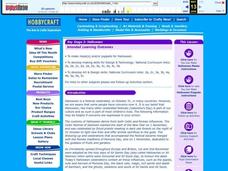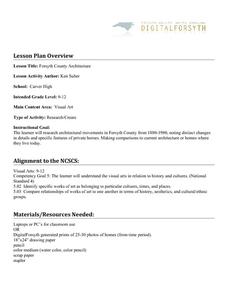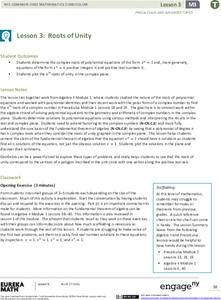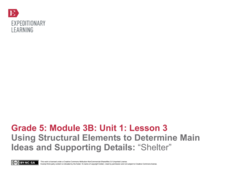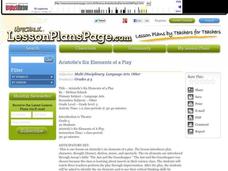Curated OER
Halloween
Discover the origins and traditions of Halloween with a crafty lesson plan! Second graders create bats, monsters, witches, and ghosts with masks and puppets. Next, they share their work with their classmates in a fun celebration.
Curated OER
Combating Corrosion
Study corrosion on bronze statues with a hands-on lesson. As pupils place a penny in water with salt, they observe the changes in the penny throughout a period of a week. They then analyze the pre-conservation and the post-conservation...
Curated OER
Forsyth County Architecture
What features mark a building as belonging to a particular culture, time, and place? Class members investigate the architectural movements represented in structures built in Forsyth County, North Carolina from 1880-1980 by examining...
Curated OER
Leonardo da Vinci: Artist, Scientist, Inventor
Students explore the connection of art, science, and history during the Renaissance Period. In this art instructional activity, students watch a PowerPoint presentation with examples of da Vinci's work. To finish this instructional...
Curated OER
Using Bar Graphs to Understand Voting Patterns
Bar graphs are used as a way to study voting patterns in the United States. A variety of statistical data is presented in the graphs, and pupils must interpret the data in order to make a report to the class. Three excellent graphs,...
Digital Forsyth
Restoration Project
In need of a neat idea that incorporates technology skills, art, and history? Young art historians will each select an old photograph from a local archive to digitally restore. The primary focus is to add color, clarity, and remake the...
Illustrative Mathematics
Making Hot Cocoa, Variation 2
Learners are introduced to dividing by fractions in a visual way. Setting up groups from the information in the problem allows them to see what we divide and why. Use with the previous instructional activity, which can be found in...
Curated OER
The Lines of Perception
Here are four engaging lessons that focus on visual art, but also bring in elements of science and social studies. Learners view artwork, locate focal points, and visit and research community sites. They conduct internet research, and...
Curated OER
Human Coordinate Plane: An Array of Desks
Use a kinesthetic activity to elucidate ordered pairs and coordinate planes. Arrange desks in a square array and distribute to learners cards with ordered pairs based on the locations of their seats. By having various groups of learners...
Illustrative Mathematics
Guess the Marbles in the Bag
Use this activity to help your class develop an understanding of greater than, less than, and equal to with numbers valued between 1 and 10. Secretly place a number of marbles (between 1 and 10) in a brown paper bag. Then shake the bag...
Illustrative Mathematics
Coffee by the Pound
This is a great exercise in graphing proportional quantities to interpret the unit rate as the slope of a graph. It is not easy for learners to understand what a unit rate is. When it is presented as the slope of a linear line graph,...
Curated OER
Vowel Lessons: To Help Improve Spelling
There are a few things every good speller knows: spelling rules, vowel sounds, and word endings. Help your learner with dyslexia become a more efficient speller with a few tips from a dyslexia expert. Included in the lesson is a video,...
Hotchalk
Triangle Sum Theorem
Your visual geometry learners will appreciate triangle drawings as they model the triangle sum theorem and algebraically solve to find the missing interior angle in a triangle. Practice problems increase in complexity and vary in their...
Academy of American Poets
Poems about Poetry
Learners of all ages hear the words “Today we’re going to start poetry” and begin their plans to drop out of school. It is not the teacher's fault! Use this resource to help young scholars understand the genre of poetry and why it is...
EngageNY
End of Unit 3 Assessment: On-Demand Writing— Photograph and Song Choices for a Film
Ready, set, write! Every great film begins with a script, and every presentation starts with a plan. Directors use their research and experience to compose an essay explaining the rationale behind their film's musical and visual choices...
National Nanotechnology Infrastructure Network
Big vs. Little - Macro to Micro Lesson 3
A nanometer is the approximate distance your fingernail grows in one second. Hard to visualize, isn't it? The third of a five-part lesson on scale seeks to help learners understand the size of the nanoscale of measurement. Using examples...
EngageNY
Roots of Unity
Visualize the nth roots of unity. Pupils calculate the nth roots of unity and find all n roots. Learners plot the solutions in the complex plane and observe that they are the vertices of a regular n-gon inscribed in the unit circle....
EngageNY
End of Unit Assessment, Part 1: Revising Claims and Evidence based on Feedback
What to do with all that feedback? Scholars use colored writing instruments to circle any feedback that relates to the first two rows of the grading rubric. After working on revisions for their papers, learners view the performance task...
EngageNY
Using Structural Elements to Determine Main Ideas and Supporting Details: “Shelter”
Does the picture tell the story? Learners continue their work in The Inuit Thought of It by creating a visual gist of pages 16 and 17. They then complete a main idea graphic organizer and discuss key supporting details.
NASA
Introduction: Building Claims from Evidence
Making a claim without supporting it has little value. Learners work on their claim-making skills in a well-designed instructional activity. They view still images from a video and make claims using support from the visual...
Curated OER
Paper Spiders
The positional words up and down are the focus of a language and visual arts lesson. Learners get a paper plate and eight strips of construction paper. They create a spider out of their paper plate, and cut out a circle out of a piece of...
Curated OER
Aristotle's Six Elements Of A Play
Fifth graders view the play, The Ant and the Grasshopper. They define Aristotle's six elements of a play. At the end of the lesson, 5th graders be asked to participate in the play by acting like busy ants. This lesson would tie in nicely...
Curated OER
Modeling the Seasons
Junior geologists become the force that makes the world go around! With a lamp on the floor in the middle of the room to represent the sun, volunteers hold a globe, revolve, and rotate. Observers notice how the light hitting the globe...
Curated OER
Painting Faces: Interpreting Portraits
Over the course of four sessions, upper elementary learners explore the elements of visual art and portraiture and the work of Canadian painter Robert Harris (links included). (Paintings by any portrait artist will fit the plan; choose...


